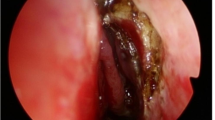Abstract
Objectives
To study the outcome of endonasal endoscopic dacryocystorhinostomy (DCR) with or without mucosal flap preservation, without mitomycin local application, silicon tube stenting or laser assistance. To determine the duration of the surgical procedure of DCR, influence of simultaneously performed endonasal endoscopic procedures for concomitant sinonasal diseases.
Methods
Combined retrospective and prospective study in our tertiary referral center. 24 patients with chronic dacryocystitis underwent 25 standard endonasal endoscopic DCR procedures, 10 with and 15 without mucosal flap preservation. 6 of these had concomitant sinonasal diseases for which they underwent septoplasty or functional endoscopic sinus surgery (FESS) or both, simultaneously or as staged procedures. Relief from epiphora and patency of the nasolacrimal fistula was assessed by nasal endoscopy and syringing of the lacrimal apparatus at 1 week, 3 weeks and 3 months postoperatively.
Results
Out of 18 patients who underwent only DCR, 17 patients (94.44%) had complete relief from epiphora. Out of 6 patients who underwent 7 DCRs with concomitant sinonasal surgery, 5 patients (85.71%) had complete relief from epiphora. Overall 23 out of 25 DCRs (92%) had complete relief. In 15 of the 25 procedures, mucosal flap was excised completely. In remaining 10 procedures, flap was trimmed, repositioned to cover exposed bone around the newly created nasolacrimal fistula. In either situation, only one patient each had partial block of the nasolacrimal fistula. Average duration of the surgical procedure of DCR was 18 min.
Conclusion
Endonasal endoscopic DCR is a viable alternative to external DCR, co-existing sinonasal diseases can be managed simultaneously, as may be required in 25% of cases. It can be performed under 20 min without mucosal flap preservation, mitomycin local application, silicon tube stenting or laser assistance and can still provide a good success rate (92%) with less complications.
Similar content being viewed by others
References
Hartikainen J, Antila J, Varpula M (1998) Prospective randomized comparison of endonasal endoscopic dacryocystorhinostomy and external dacryocystorhinostomy. Laryngoscope 108:1861–1866
Welham RA (1997) Clinical ophthalmology. Miller S Ed, IOP Publishing Ltd: Bristol (Indian Edn); 391–441
Metson R (1990) The endoscopic approach for revision DCR. Laryngoscope 100:1344–1347
Sprekelsen MB, Barberan MT (1996) Endoscopic dacryocystorhinostomy: surgical techniques and results. Laryngo-scope 106:187–189
Umer MN, Schreiber S, Yung MW (2007) Concomitant nasal procedures in endoscopic dacryocystorhinostomy. J Laryngol Otol 121(12):1170–1176
Ramakrishnan VR, Hink EM, Durairaj VD, Kingdom TT (2007) Outcome after endoscopic dacryocystorhinostomy without mucosal flap preservation. Am J Rhinol 21: 753–757
Selig YK, Biesman BS, Rebeiz EE (2000) Topical application of mitomycin-C in endoscopic dacryocystorhinostomy. Am J Rhinol 14:205–207
Smirnov G, Tuomilehto H, Terasvirta M, Nuutinen J, Seppa J (2008) Silicon tubing is not necessary after primary endoscopic dacryocystorhinostomy: a prospective randomized study. Am J Rhinol 22:214–217
Maini S, Raghava N, Youngs R, Evans K, Trivedi S, Foy C, et al. (2007) Endoscopic endonasal laser versus endonasal surgical dacryocystorhinostomy for epiphora due to nasolacrimal duct obstruction: prospective, randomized, controlled trial. J Laryngol Otol 121(12):1170–1176
Cunningham MJ, Woog JJ (1998) Endonasal endoscopic dacryocystorhinostomy in children. Arch Otolaryngol Head & Neck Surg 124:328–333
Author information
Authors and Affiliations
Corresponding author
Rights and permissions
About this article
Cite this article
Deviprasad, D., Mahesh, S.G., Pujary, K. et al. Endonasal endoscopic dacryocystorhinostomy: our experience. Indian J Otolaryngol Head Neck Surg 61, 223–226 (2009). https://doi.org/10.1007/s12070-009-0071-z
Published:
Issue Date:
DOI: https://doi.org/10.1007/s12070-009-0071-z




